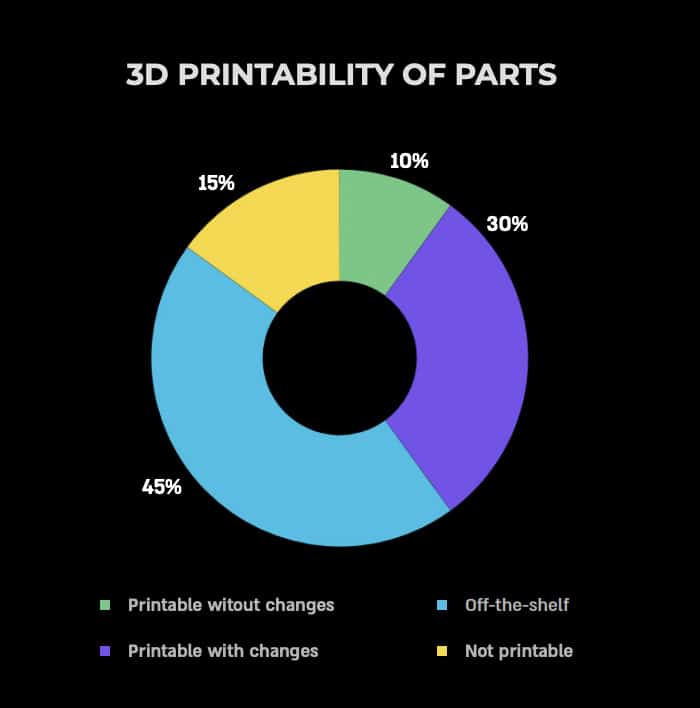CASTOR, an Israeli-based software company, helps manufacturers with one of the hardest challenges in successfully implementing AM for production: identifying where, when, and how to use 3D printing to reduce costs. The company’s software has analyzed over 30,000 parts to date or assemblies uploaded to CASTOR in the period 2019 – 2021. The findings are presented in the CASTOR 2021 AM Trends Report.
A key feature of the CASTOR platform is the ability to process thousands of parts in parallel, giving unprecedented depth to insights that can only be generated from part analysis at scale. The entire 15-page CASTOR 2021 AM Trends Report report, which is available to download for free here, found that 40% of the 30,000 parts would benefit from using 3D printing in production. One-quarter of these (10% of total) do not require any design modification to be proficiently 3D printed, while three-quarters of these (30% of total) would benefit from AM production only after some design modifications.

“To fully understand and exploit the potential of AM, we ask a key question that is essential to the future growth of the industry,” commented Omer Blaier, Co-Founder and CEO of CASTOR: “When does AM make sense? It seems like a simple question but is in fact more complicated than it first appears […] Using AM without a business case can be a frustrating experience […] CASTOR’s software […] enables the manufacturer to quickly check if a part, or an assembly of parts, can be suitable for production by AM, both geometrically and economically. With two full years of experience in the use of the CASTOR software and 30,000 parts and assemblies analyzed, we realize that we stand at a unique place in the understanding of the needs of manufacturers in the area of AM.”
Manufacturing on Demand
The pandemic year caused many AM companies, especially growing startups, to forego visits to potential customers, forcing many of them to spend time in the laboratory to improve their products and develop new applications. Every year a greater variety, and a larger share, of AM activity is devoted to end-use manufacturing, and not the product development process. This leads to the need to identify the business cases where AM parts make sense compared to traditional manufacturing methods, has become a key aspect in the decision-making process among managers of production, the supply chain, and R&D. In some areas, the break-even point between AM and traditional manufacturing continues to be extended, meaning that with each passing year the AM net is cast wider to capture products and applications that were not feasible in the same quantities just the year before.
Additionally, the pandemic and the growing concern over climate change have drawn attention to additional benefits of AM: avoiding disruptions in supply chains through the flexibility of digital on-demand manufacturing, and reduced environmental impact through distributed manufacturing, and lower material usage through sophisticated design options such as light-weighting.
The AM Trends Report also highlights that among the printable parts, 20% can save costs compared to traditional manufacturing. A Break-even point in cost is often not as important as a breakeven point in time, especially in periods of disrupted supply chains, so a final analysis of whether to print or not needs to take into softer factors such as available lead time and other commercial considerations. In the case of spare parts, the cost of downtime could be a critical or dominant factor.
The CASTOR 2021 AM Trends Report finally points out that as many as 7.5% of parts can be reduced in weight by using AM as a production process. Automatic tools such as bulky area identification and hollowing tools can ease the weight-reduction process of AM parts without compromising part integrity or strength requirements. Of these, almost a quarter of the parts could be reduced in weight by over 50% and more than half could be reduced by over 25%.
* This article is reprinted from 3D Printing Media Network. If you are involved in infringement, please contact us to delete it.
Author: Davide Sher

Leave A Comment